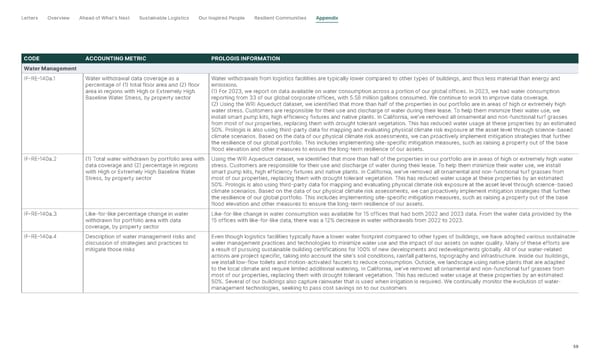Letter s Overview Ahead of What’s Next Sustainable Logistics Our Inspired People Resilient Communities Appendix CODE ACCOUNTING METRIC PROLOGIS INFORMATION Water Management IF-RE-140a.1 Water withdrawal data coverage as a Water withdrawals from logistics facilities are typically lower compared to other types of buildings, and thus less material than energy and percentage of (1) total floor area and (2) floor emissions. area in regions with High or Extremely High (1) For 2023, we report on data available on water consumption across a portion of our global offices. In 2023, we had water consumption Baseline Water Stress, by property sector reporting from 33 of our global corporate offices, with 5.58 million gallons consumed. We continue to work to improve data coverage. (2) Using the WRI Aqueduct dataset, we identified that more than half of the properties in our portfolio are in areas of high or extremely high water stress. Customers are responsible for their use and discharge of water during their lease. To help them minimize their water use, we install smart pump kits, high efficiency fixtures and native plants. In California, we’ve removed all ornamental and non-functional turf grasses from most of our properties, replacing them with drought tolerant vegetation. This has reduced water usage at these properties by an estimated 50%. Prologis is also using third-party data for mapping and evaluating physical climate risk exposure at the asset level through science-based climate scenarios. Based on the data of our physical climate risk assessments, we can proactively implement mitigation strategies that further the resilience of our global portfolio. This includes implementing site-specific mitigation measures, such as raising a property out of the base flood elevation and other measures to ensure the long-term resilience of our assets. IF-RE-140a.2 (1) Total water withdrawn by portfolio area with Using the WRI Aqueduct dataset, we identified that more than half of the properties in our portfolio are in areas of high or extremely high water data coverage and (2) percentage in regions stress. Customers are responsible for their use and discharge of water during their lease. To help them minimize their water use, we install with High or Extremely High Baseline Water smart pump kits, high efficiency fixtures and native plants. In California, we’ve removed all ornamental and non-functional turf grasses from Stress, by property sector most of our properties, replacing them with drought tolerant vegetation. This has reduced water usage at these properties by an estimated 50%. Prologis is also using third-party data for mapping and evaluating physical climate risk exposure at the asset level through science-based climate scenarios. Based on the data of our physical climate risk assessments, we can proactively implement mitigation strategies that further the resilience of our global portfolio. This includes implementing site-specific mitigation measures, such as raising a property out of the base flood elevation and other measures to ensure the long-term resilience of our assets. IF-RE-140a.3 Like-for-like percentage change in water Like-for-like change in water consumption was available for 15 offices that had both 2022 and 2023 data. From the water data provided by the withdrawn for portfolio area with data 15 offices with like-for-like data, there was a 12% decrease in water withdrawals from 2022 to 2023. coverage, by property sector IF-RE-140a.4 Description of water management risks and Even though logistics facilities typically have a lower water footprint compared to other types of buildings, we have adopted various sustainable discussion of strategies and practices to water management practices and technologies to minimize water use and the impact of our assets on water quality. Many of these efforts are mitigate those risks a result of pursuing sustainable building certifications for 100% of new developments and redevelopments globally. All of our water-related actions are project specific, taking into account the site's soil conditions, rainfall patterns, topography and infrastructure. Inside our buildings, we install low-flow toilets and motion-activated faucets to reduce consumption. Outside, we landscape using native plants that are adapted to the local climate and require limited additional watering. In California, we’ve removed all ornamental and non-functional turf grasses from most of our properties, replacing them with drought tolerant vegetation. This has reduced water usage at these properties by an estimated 50%. Several of our buildings also capture rainwater that is used when irrigation is required. We continually monitor the evolution of water- management technologies, seeking to pass cost savings on to our customers 59
 2023-24 ESG Report Page 58 Page 60
2023-24 ESG Report Page 58 Page 60